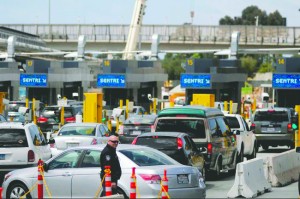By Estephania Baez
Tijuana and San Diego truly live the slogan “Two Cities, One Region”, which has been used by their respective representatives when talking about the two cities. Their aim is to become the fastest and most dynamic border in the world and, to that end, this mega-region has been implementing a series of innovative projects at the different Ports of Entry into the U.S.
In November, 2014, the first phase of the modernization of the San Ysidro POE was inaugurated, consisting of expanding to 25 northbound lanes with 46 tandem booths – and the construction of a new Customs and Border Protection (CBP) administrative building – in order to reduce border wait times to 15-40 minutes. This goal was achieved during the first three months of operation after the expansion, however, wait times are once again on the rise. The remaining phases are expected to be concluded by 2018. The overall modernization project consists of three phases: phase one was the primary and secondary inspection facilities, the administration building, and the San Ysidro bridge; phase two will be the construction of a new northbound pedestrian crossing; and phase 3 will connect I-5 directly to the El Chaparral southbound facilities, as well as invert the old southbound lanes and add them to the 25 existing northbound lanes to reach a total of 33 lanes.
According to a General Services Administration (GSA) study, more than 50,000 vehicles cross through San Ysidro each day, and that number is expected to grow by up to 87% by 2030. Because more than 18 million vehicles and 8 million pedestrians cross through this POE each year, reducing border wait times has become a priority for both Californias. The San Ysidro Chamber of Commerce has stated that these border wait times cost San Diego County $7 million a year in losses.
California’s border crossing projects are about halfway done, with an overall investment of $2 billion dollars, according to the Director of Border Crossings. All of these projects are LEAD-certified, making them not only environmentally-friendly but also greatly reducing their energy use. One of the top priorities for this year will be pedestrian border crossings, he added.
“We are convinced that it will have a huge impact on border crossings in both directions; we are already working on the last two phases for the San Ysidro Port of Entry, and we are working with the State of California on the new Otay East POE as well as on Calexico West, with which we would finish the works for the California-Baja region” shared GSA’s Border Land Ports of Entry Director Ramon Riesgo.
Cutting-edge technology is also being implemented at the pedestrian border crossings. The first week of December CBP launched a biometric border entry and exit control pilot program. During its first phase, non-U.S. citizens entering the country on foot through Otay Mesa would go through a facial recognition and iris scans at booths set up for that purpose. During the second phase, to be launched in February, foreigners will also undergo biometric scans when exiting the U.S. The program has been in effect for one month so far, without any reported complaints.
“Its quick; they just help you place your card and documents – a minute or two – I placed my visa and the device began to shine and I had to stand to have my eyes scanned to make sure they matched my passport”, explained Mindy Mishelle, one of the first people to use it.
In addition, another pilot – The Otay Mesa Cargo Pre-Inspection Program – was inaugurated today by U.S. and Mexican authorities.
“It is a pre-inspection facility, a pilot program in the city of Tijuana, where CBP officers will work alongside Mexican Customs officers and representatives from both country’s Departments of Agriculture to inspect agricultural commodities that meet certain requirements. This promises to expedite cargo crossings in general, as these trucks would be diverted from having to wait with the rest of the trucks at the [northbound] cargo facility” – indicated Alejandra Mier y Teran, Director of the Otay Chamber of Commerce.
Additional booths, the use of the latest technology, and other factors have allowed what once seemed lightyears away to become today’s reality.